Article
Making the Most of Montreal
Author(s):
At the end of the Andersons' cruise on Le Boréal the final stop is Montreal. With its Place Royale that goes back to 1676, all its historic buildings and its cuisine, Montreal is the perfect end to the cruise through French Canada.
Photography by the authors
Le Boréal
has sailed but it’s left us in Montréal which is, some would say, the prize of the cruise. Montréal is described by its mayor, Gerald Tremblay, as a “city that is on the move.” We are not sure what that means or even if we want this ancient city — in any way — to change.
we
With its Place Royale that goes back to 1676 and all its historic buildings we are very pleased to accept Montréal as is. We don’t want it to move. But have to move if we want to see more than the basics in a single day.
So where should we walk first?
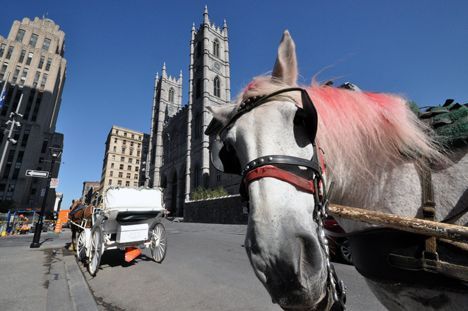
The Catholic Church has dominated this city. It seems appropriate to stand outside Notre-Dame and ask local carriage drivers for ideas. We had thought we’d get this advice straight from the horse’s mouth, and so we do and cross the street to see this Gothic Revival masterpiece, the cathedral. The world’s current financial hardships must be hurting even the church: Notre-Dame now charges people $5 to enter! The interior, however, illustrates 350 years of parish history and bathes the paintings and sculptures in a beautiful blue glow.
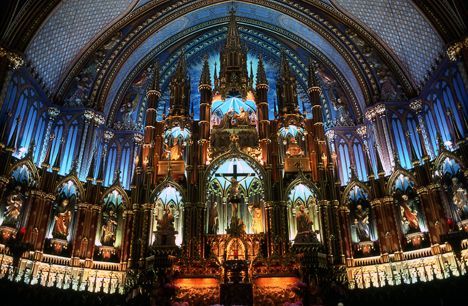
Less than half a mile east along Rue Notre-Dame sits a long building that looks like an army barracks, the Chateau Ramezay. It was actually a private home but this 18th century residence was turned into a museum in 1895. Its collections go back more than 500 years even to what Canadians call pre-contact Amerindian days.
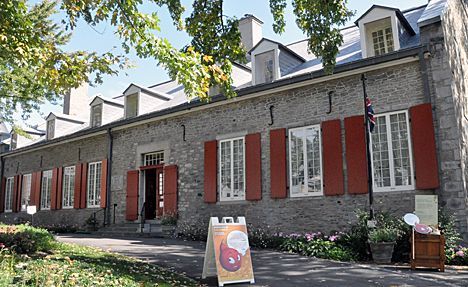
Trécarré
1001 Historic Sites You Must See Before You Die!
Chateau Ramezay is a marvelous, unexpected jewel of a museum with enough exhibits to keep visitors enthralled all day. A UNESCO publication has chosen it as one of That’s a long bucket list for sure but this museum is a pleasure.

The displays in Chateau Ramezay remind us war is part of any history. They show weapons that were part of Montréal’s stormy centuries, from the sword of a captain in the 5th Battalion of the Chasseurs Canadiens to a Fraser Highlander’s dagger, and from the pistol of General Sir James Murray, the first governor of the city, to an Amerindian axe-shaped pipe, and Cree (left, in photograph) and Sioux (on the right) knives.

Other exhibits show war is not everything. The museum has simple “historical figures recounting in six languages highlights of their life in the chateau.”
history
cuisine
The walk back towards Notre Dame takes you past several cafés, a welcome sight in a province that prides itself on its French cuisine. Indeed, a guide in the Province of Québec once told us; “Come to the city of Québec for its not for its food; Come to Montréal for its !”
When we asked why, he said, “Montréal is a sophisticated city with magnificent restaurants. Québec was a town of farmers, meat and potatoes people, enjoying peasant food. It hasn’t changed.”
We took note of that in the vain hope of having a publisher one day who might allow an expense account.
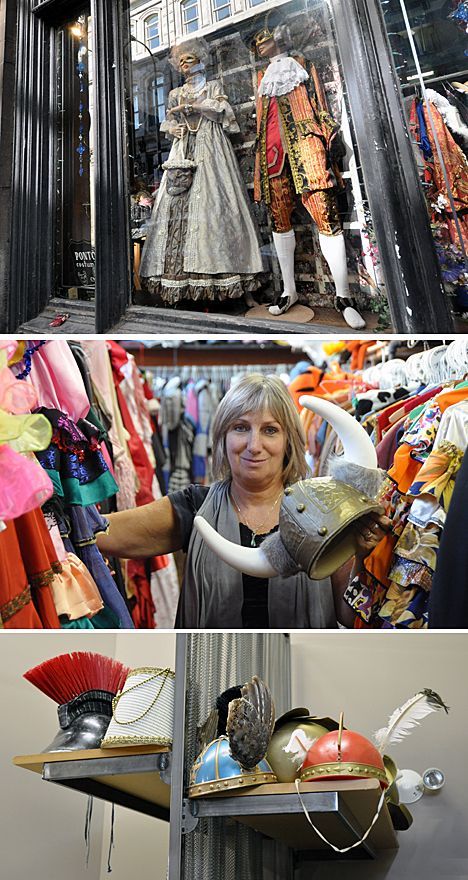
Around the corner from the cathedral a shop window beckons. The sign in the window says Ponton Costumier Depuis 1865. We are hooked. Joseph Pontoon Costumes, the largest and oldest costume shop in the whole province of Québec, has been in this strange make-believe business since 1865. He has 15,000 costumes in stock. (Seems like more to us!)
The shop certainly has a variety of clothing from Napoleonic military to suits of armor that are either from the Crusades or Star Wars. And an assortment of rubber face masks from Queen Elizabeth to President Obama, neither flattering, of course, but that may be what makes them fun.
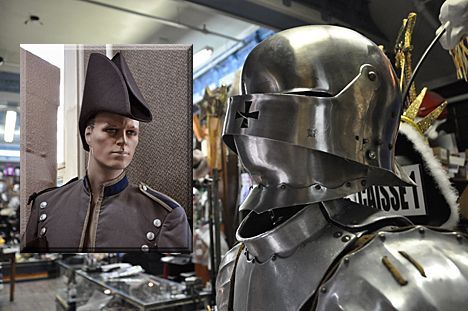
Who
We ask Jocyln — she started in the store in 1979 — “ are your customers?’
“Everybody,” she answers. “Planners for conventions — including ones for doctors!” She smiles and continues, “People putting on parties, staging movie mysteries, arranging seasonal events like Halloween or Christmas, and people…” She hesitates.
“People?” we ask.
“Well, some people just like to dress up. They come in here and try on a costume, get in a role then I hear them singing in front of a mirror!” She pauses then: “Johnny Depp came in recently with a group of seven. I didn’t know what to say.”
“Did he try on a pirate hat?” we ask.
She frowns a reprimand and says, “He came back later with his wife Vanessa Paradis and children — and actually got a dress and a wig for his daughter.”

We leave the world of make believe and head back to our Montréal hotel, choosing a route that will take us past Images Boréales on Saint-Paul Street East. We want to ask Matt Namour the owner about Inuit artists like 60-year-old David Ruben whose work some of our friends have started mentioning. We ask why Inuit art is now better recognized.
“Because it speaks to us more than any other kind of art,” he replies. “It can be contemporary but you can see how it keeps its traditions. Shaman sculptures in particular are fascinating, in some you can feel, even see in a carving, for example, man changing into a caribou.”
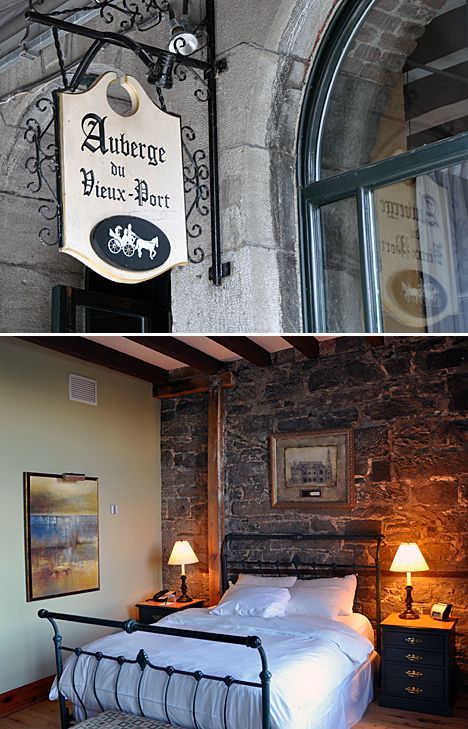
We need to change too — for dinner at whichever restaurant smells good and they all do. We end back at the perfect hotel the Compagnie du Ponant had chosen for those passengers staying on at the end of the cruise from Boston for an extra day in Montréal: Auberge du Vieux Port, the Inn of the Old Port.
A quick cab ride from the harbor, right in the middle of old Montréal within easy walking distance of all the attractions in Old Town and close to many restaurants, this 27-room hotel with creaking floors that offers a huge cooked breakfast as part of your stay, leaves a charming reminder of what’s delightful in Québec Province’s most interesting city.
Visit the other stops on the Andersons' trip with Le
The Town Named for the Hole in the Wall
The Mingan Islands' Daughters of the Sea
Tadoussac and the Youngest Victorian Hotel
Where a New France Found its Foot in a New World
The Man Who Cried Orange: Stories from a Doctor's Life.
The Andersons, who live in San Diego, are the resident travel & cruise columnists for Physician's Money Digest. Nancy is a former nursing educator, Eric a retired MD. The one-time president of the NH Academy of Family Practice, Eric is the only physician in the Society of American Travel Writers. He has also written five books, the last called
Boréal:Québec




